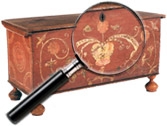|
|
Captain Hall J. Tibbits (American, 1797 to 1872)
This article about the life and career of Captain Tibbits by Eric C. Rodenberg appeared on the 4 November 2013 front page of Antique Week’s National Section. Used by permission. http://www.antiqueweek.com.
1800s Sea Captain’s Life Told Through Collection
At 6 foot, 4 inches tall and “powerfully built” Capt. Hall Jackson Tibbits would brook no foolishness.
After his “religious principles” were violated by passengers dancing on [...] Click here to continue reading.
Just about any culture with paper has a form of paper-cutting decoration, but establishing much of the history is tricky because of the fragile, ephemeral nature of paper. Still, we know that China and Japan were practicing paper-cutting very early, and the usage depends on the culture. In Japan, paper-cutting was used to create decorations for the home, while in Jewish and Eastern European cultures, the cuttings often had a religious theme. The [...] Click here to continue reading.
Artkraft Strauss
The objects in this collection evoke a brief moment, barely a century long, when Times Square, the “Crossroads of the World,” was defined by neon, that glorious and now almost extinct medium that for many years was the supersign’s soul.
Neon spectaculars, examples of which you will find in this auction, represent a golden age of handmade industrial artistry, lost now to digitalization and prefab vinyl displays, but of ever-growing interest, due [...] Click here to continue reading.
The Battleship Maine
Construction of the U.S.S. Maine was authorized in August of 1886, and she was launched in 1889 and commissioned in 1895. After several years spent patrolling the East Coast and Caribbean, orders sent the Maine and her crew to Cuba in response to continued civil unrest on the island.
The photograph above is a 1896 image of the ship framed in a sheet iron frame made from remnants of [...] Click here to continue reading.
The Sarcophagus in Decorative Arts
Derived from the Greek sarx, meaning flesh, and phagein, meaning eat, a sarcophagus is, essentially, a container for a body, much like a coffin or casket. Historically, sarcophagi were typically made of stone (though sometimes of other materials, such as wood or metal), with a relief-carved or pediment top, and designed to be above ground, and have been used by many cultures since ancient times.
An ancient [...] Click here to continue reading.
Apocryphal – Definition
Apocryphal, the adjective form, means “of doubtful authenticity,” according to Merriam-Webster’s online dictionary. Apocrypha, the noun form, means “writings or statements of dubious authenticity,” again according to Merriam-Webster.
Apocrypha is actually a Greek word that means something closer to “obscure” or “hidden away.” The original meaning of the word, the Apocrypha in the proper noun sense, refers to religious texts outside of the traditional or accepted religious canon. Through connection with [...] Click here to continue reading.
Elijah Pierce (1892 to 1984)
Elijah Pierce was born on March 5, 1892 on a Mississippi farm, the son of a former slave. After receiving a pocketknife from his father, Elijah began carving. It might not have amounted to much without the guidance of his uncle, Lewis Wallace, who helped him learn the basics, like choosing the right kind of wood for a project. By the age of seven, he was carving small animals [...] Click here to continue reading.
Bakelite
Scandal & the Story of Bakelite Bakelite hit the market in 1907, heralding the arrival of the modern plastics industry. Bakelite was the first completely man made plastic, as until then, plastics such as celluloid, casein, and Gutta-Percha all had as a base a natural material. It was developed by Belgian-born chemist Dr. Leo Hendrick Baekeland who started his firm General Bakelite Company to produce the phenolic resin type plastic. Bakelite was inexpensive [...] Click here to continue reading.
Baleen, Plastic of the 18th Century
Baleen comes from a suborder of whales, Mysticeti, which includes, among others, humpback whales, gray whales, right whales and blue whales. What sets these whales apart is baleen. These whales do not have teeth, but have upper jaws filled with two rows of baleen plates fringed with fine baleen hair. These plates are so closely aligned that they act like a comb or a sieve; whales pull water [...] Click here to continue reading.
Marion and Donald Woelbing, Franklin Wisconsin.
Marion and Donald Woelbing were the solid citizen types that for generations have built American small businesses. They were a true partnership supporting each other in their diverse interests ranging from breeding and showing American Kennel Club grand champion prize winning dogs, to building with their own hands “Thorntree,” their home in suburban Milwaukee, to building an impressive collection of 17th and 18th century American antiques, to collecting [...] Click here to continue reading.
|
Recent Articles
- Charles Alfred Meurer – American Artist & Tromp L’Oeil Artist
- Sendak, Maurice – American Artist & Writer
- Godie, Lee – American Artist
- Davis, Vestie – American Artist
- Bartlett, Morton – American Artist
- Mackintosh, Dwight – American Artist
- Evans, Minnie Jones – African-American Artist
- Mumma, Ed (Mr. Eddy) – American Artist
- Nice, Don – American Artist
- Savitsky, John (Jack) – American Artist
- Gordon, Harold Theodore (Ted) – American Artist
- Dial, Thornton – African-American Artist
- Doyle Sam – American Artist
- Johnson, Lester Frederick – American Artist
- Finster, Howard – American Artist
|
|
